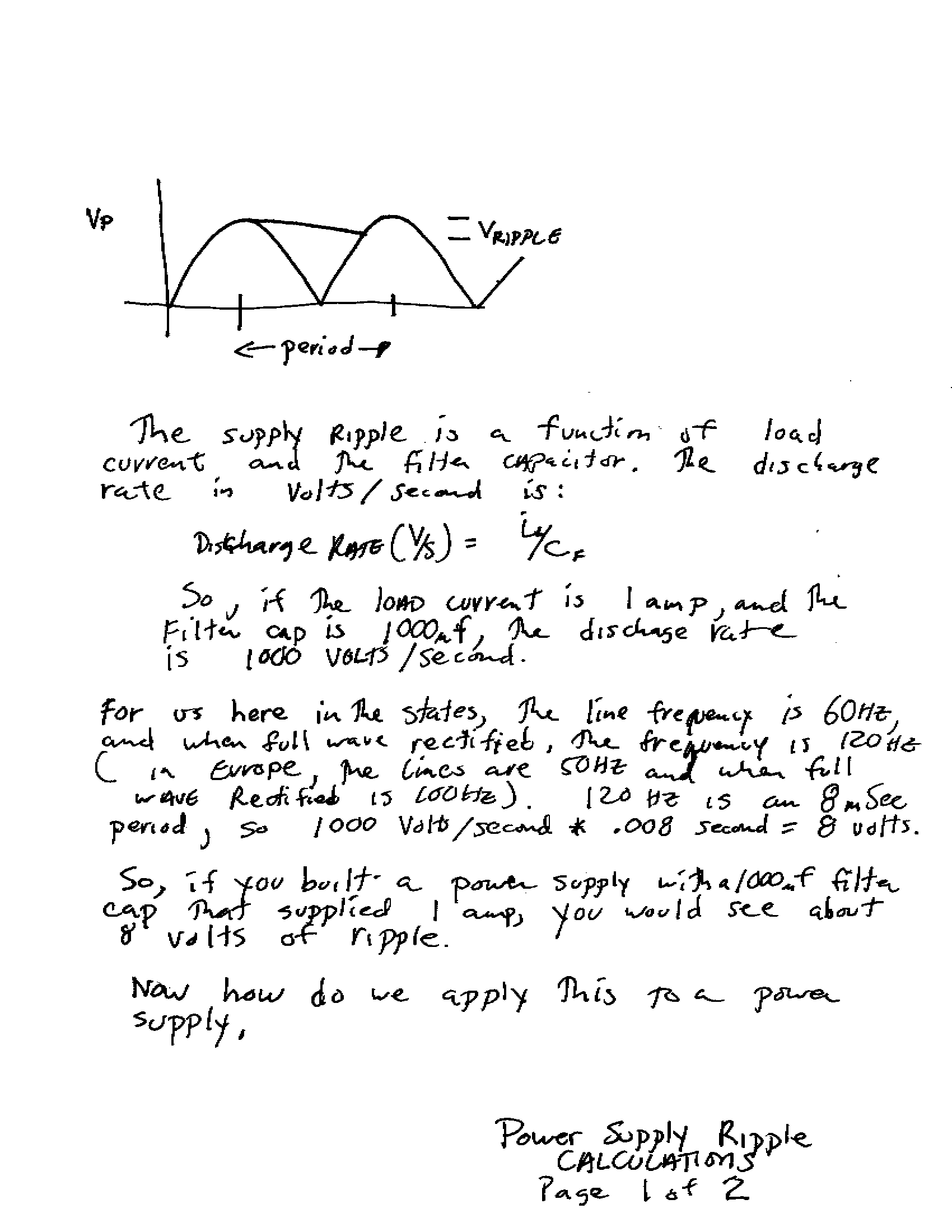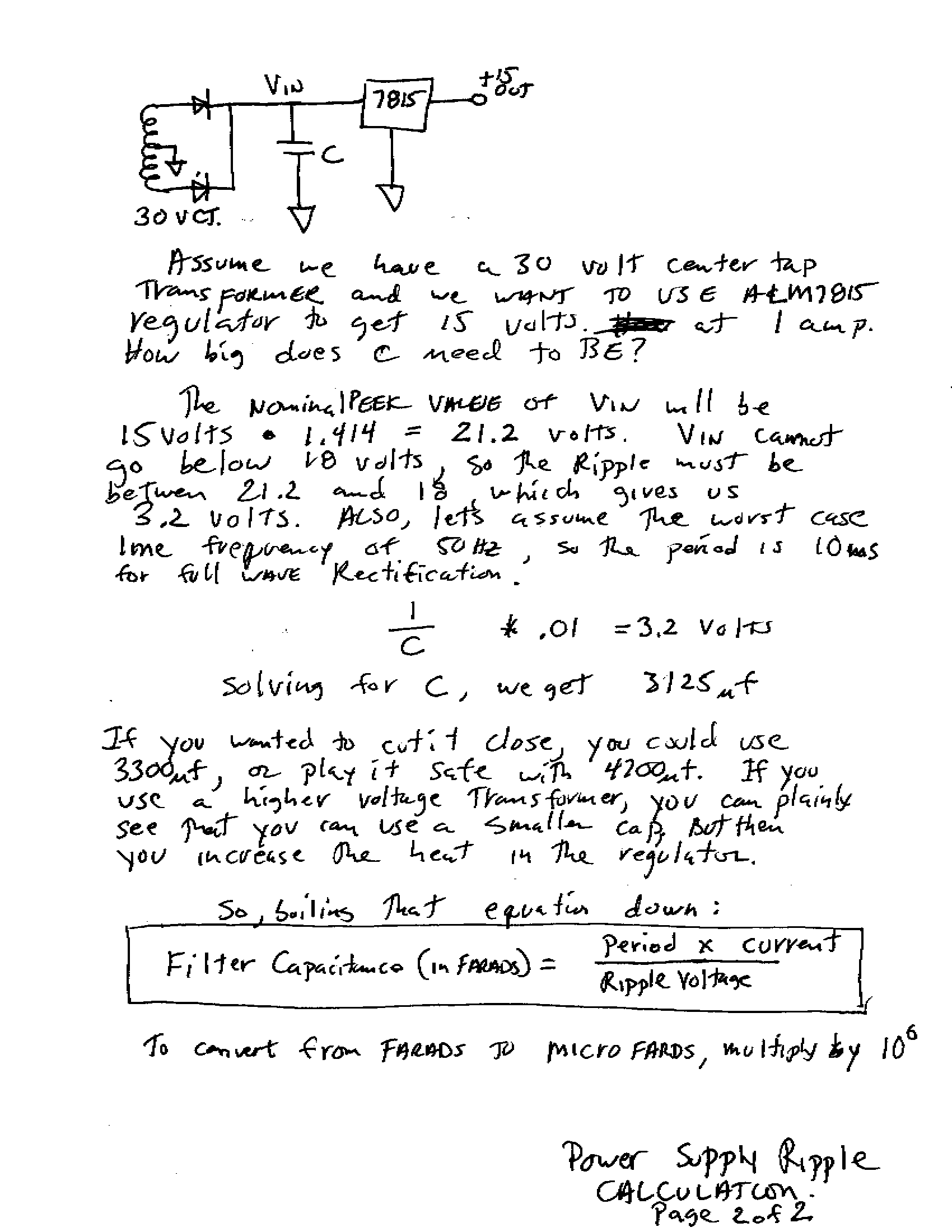
Power supplies, so simple, and yet, sometimes very difficult to deal with. Many time troubles can be traced back to either inadequate or poorly designed power supplies. There are two major catagories of power supplies, linears and switchers. In general, for do it yourself projects a linear is a better choice as switchers can be cantancerous. However, if the amount of power that is required is large, a switcher is sometimes the best option.
Linear Power Supplies
A good linear power supply can be very simple to build. Three terminal regulators, while not exactly the best in the world, will generally to a very adequate job of regulating voltage. The biggest problem is getting rid of the heat. Let's look at an example. For a +/- 15V power supply, generally a 35VCT transformer is about the best choice. After you rectify and filter the transformer output you will have about +/- 24VDC. This is actually the peak voltage. If you look at a loaded down supply, you will see a 120Hz sawtooth kind of wave. For a 15 volt regulator, this voltage can never go below 18 volts, typically. So let us just suppose that the average voltage, under load, is about 21 volts. If the load current is 1 amp, then (21 - 15) * 1amp = 6 watts of power that needs to be disapated. This is a lot of power. You are going to need a sizable heat sink to get rid of this much heat. For example, to be conservative you could pick something like the Jameco DUDE4 TO3 heatsink. There are other heatsinks you could use, but this one is sure to do the job.
Wiring is another big problem.
And an even bigger problem to relate to those who lack experience.
When putting together a power supply circuit, you must keep in mind that
all wires have a finite resistance. It is posible to wire a power
supply so that the regulators are amplifying the voltage drops in the wires,
thus making a noisy power supply. One of the big sources of this
kind of noise is the current flowing through the filter capacitors.
Generally, it is best practice to create a "star" connection consisting
of the center tap from the transformer, the filter capacitor(s) common,
and the ground return from the powered equipment, and the commons from
the voltage regulators and their bypass caps. By star, I am meaning
a single point with connections radiating outward, like a star. This
is also refered to as a single point ground. You can also run a connection
from this star point to your chassis.
Power
Supply Board
Power Supply Interconect
Power Supply PCB Layout
When you construct your power supply, I strongly recomend you put it in a metal box. The reason is quite simple. Fire safety. Transformers do sometimes catch on fire. I had this happen once, and it was a close call. No damage due to the fact that I thought something odd was happening. But, it was just sitting on a wooden table top, and flames were about 12 inches high coming off of the transformer. Keeping it in a metal box would have made this a much safer situation. Also, make sure that you have the proper size fuse in the AC circuit. This will also help prevent any tragidies, like having your Arp 2600 going up in smoke.
Usefull parts and where to get them:
Heatsinks:
DUDE4
Jameco
HS103-1.25-ND
Digikey----Diecast Good for about 10-15 Watts, maybe (catalog says 25 watt's,
ha!)
HS103-0.50-ND
Digikey----Diecast Good for about 5-7 Watts (catalog says 17 watts)
294-1087-ND
Digikey----Stamped Good for about 7-10 Watts (catalog says 12 watts)
294-1096-ND
Digikey----Diecast-This thing goes on top of TO-3, Good addition to above
to increase cooling, adds another watt or two of disipation.
Transformers:
HM536-ND
Digikey---18VCT, 3APMS, Use 10,000uF Filter cap and LM323 5 volt reg to
make logic supply for up to 3 amps. Mount regulator on DUDE4 above.
HM535-ND
Digikey---18VCT, 1.5 Amps. Use 4700uF Filter cap and LM7805 5 volt
reg to make logic supply for up to 1.5 amps. Either use the DUDE4
or HS103-1.25-ND with 294-1096-ND. In theory, you could use a 10,000uF
cap and the LM323 and get 3 amps. If you use a full wave center tap
type rectifier, since only one half of the transfromer is working at a
time, it is like hooking to two halves of the secondary in parrallel, thus
giving you the 3 amps.
HM567-ND
Digikey----36VCT, 1.0 Amps. Use for +/- 15 volt supply, 1 amp.
HM553-ND
Digikey----25VCT, 1.0 Amps. Good for +/- 12 volt supply, 1 amp


It should be noted that the above exersize can also be applied to half wave rectifiers as well. Just remember that the period will be same as that of the line frequency.
Line Frequency
Half Wave Period Full Wave Period
50Hz
20mSEC
10mSEC
60Hz
16mSEC
8mSEC